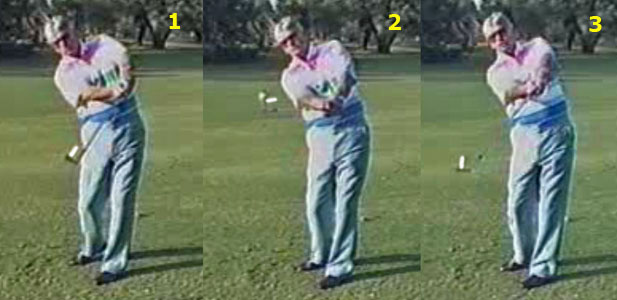First off, let's go back to what the hinge actions are briefly. Here's a pic of Tom Tomasello's hinge actions.

Again, pay attention to where the white mark is facing on the clubface.
Pic 1 = Angled Hinge (Clubface at a 45 degree angle, 'No Roll')
Pic 2 = Horizontal Hinge (Toe pointing at the target, 'Full Roll')
Pic 3 = Vertical Hinge (Face pointing at the sky, 'Reverse Roll')
Here's also a video showing the hinge actions:
The first 'swing' = Horizontal Hinge
The 2nd 'swing' = Angled Hinge
The Last 'swing' = Vertical Hinge
Now with the putter, you just want to use either the Angled Hinge or the Vertical Hinge.
In my last lesson with Ted Fort we went over this. We had taken a look at my SAM Puttlab results and he had taken a look at my putting stroke and what we saw was a 'mixing of components' for two different types of strokes. This is not a good thing.
Unfortunately, I don't have a scanner to show the SAM Puttlab results, but what it basically showed was that I had an 'arced' style of backstroke, but a Straight Back-Straight Thru (SBST) type of thru stroke.
When Ted and I discussed this he mentioned that I need to match my backstroke components and my thrustroke components together. So, I either needed to create more of an arced thrustroke or create more of a SBST backstroke.
One of the big keys here is to note that like the full swing, there are almost countless ways to effectively putt the ball. Nicklaus' putting stroke was different from Locke's, which was different from Crenshaw's which was different from George Archer's. The key is to find what works best for you.
When Stan Utley came out with 'The Art of Putting' and pretty much denounced the SBST method, he was right in that SBST method may be damaging to a lot of golfers. But, it's not to say it's not a valid method. You just need to have the proper components and a golfer who succeeds at using that method. The same for the arced stroke.
Anyway, Ted showed me two simple methods. One was for the Arced Stroke method and the other was for more of a SBST method (which Ted...a great putter in his own right...uses for his own putting stroke).
The Arced method utilizes angled hinging.
In the method Ted showed me he wanted me to feel like I was sensing the #3 Pressure Point and tracing a line back and thru the target line. Sort of like 'Right Forearm Tracing' for putting, but I was tracing the target line instead of the plane line. This would create a closed putter face at finish and a nice arcing putting stroke.
Unfortunately, I could not get it to work and I've practiced and practiced with it and my putting has pretty much stunk. If I had a very average day putting on Thursday, I would have shot about a 68 (if I had a good day putting it could've been about a 65), instead I wound up shooting a 73.
Fortunately, Ted decided to show me the other way although he didn't think at the time it would be something I would like. This method consisted of using vertical hinging and letting the shoulders rock back and forth and essentially stroking the putt with the shoulders. But it's very important to use vertical hinging. If the clubface gets too closed, I will miss everything to the left.
Ted also noted that this method requires the golfer to be more upright. I was using a Cleveland Classic #3 putter and could not get the method down partly because it has a standard lie of 70 degrees. Now I have a Bettinardi C-Series 06 putter which is 1* upright and I'm able to make the shoulder rocking w/vertical hinge putting stroke a lot easier.
Please note that I still believe I probably have *some* arc to my putting stroke, but it's much more SBST than what Utley teaches.
Perhaps two of the greatest putters ever, Ben Crenshaw and Loren Roberts, used distinctly different putting strokes, with Crenshaw being an arced stroke with angled hinging and Roberts having more of a SBST (he actually cuts across it slightly) with vertical hinging.
This picture in particular tells a lot.

Again, there's almost countless ways to stroke the ball, but the components should match each other. If you hear Crenshaw talk about putting, he talks a lot about the hands whereas when Loren Roberts talks about putting, he talks more about the shoulders rocking. So a decent idea is:
hands based stroke = angled hinging
shoulder rocking stroke = vertical hinging.
3JACK
1 comment:
Why not just swing the putter shaft on an inclined plane which lies parallel to the target line (0* Horizontal Swing Plane), impacting at low point (0* Attack Angle), to produce a 0* Clubhead Path? Eliminate the system of rotation of which the left wrist is the pivot. Power the swing with shoulder rotation and arm swing, which, by the way, both naturally produce clubface rotation on the plane. Works for Jack and Tiger.
Post a Comment